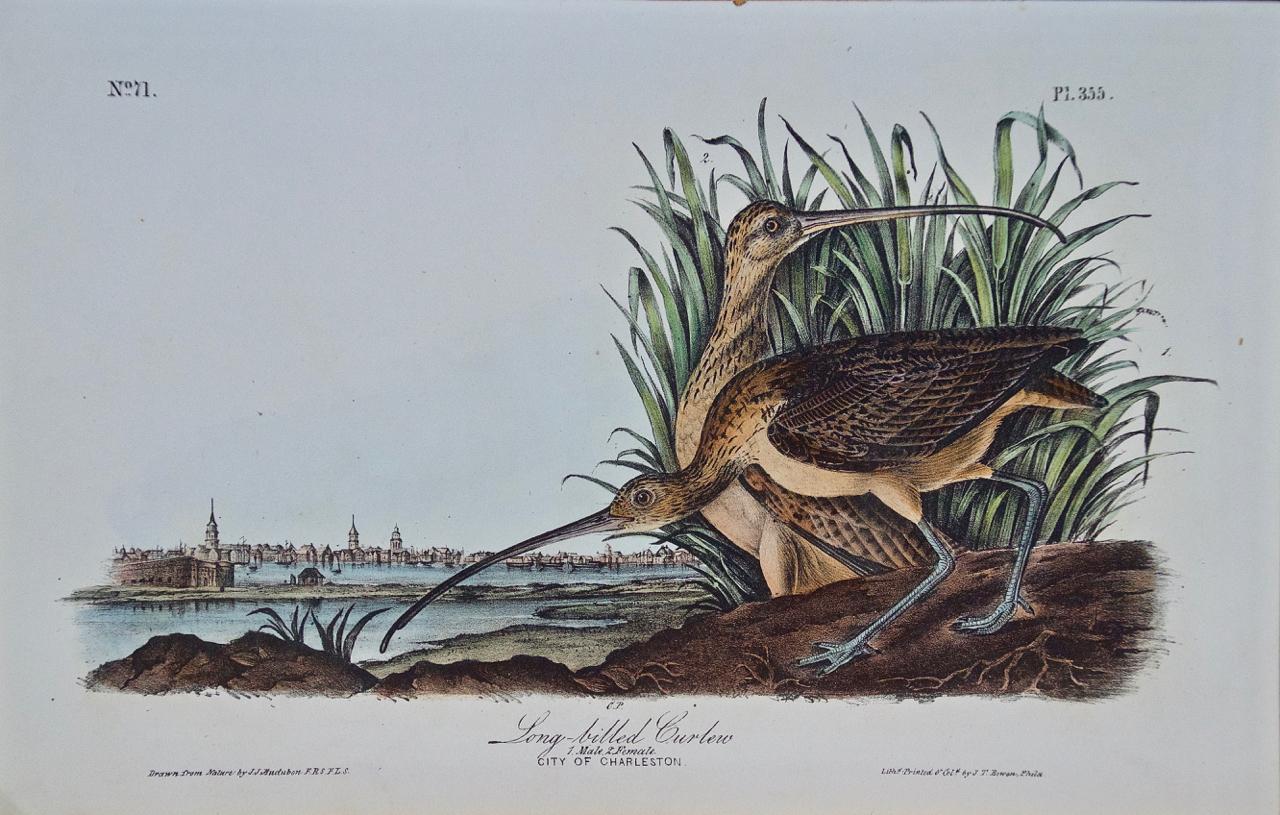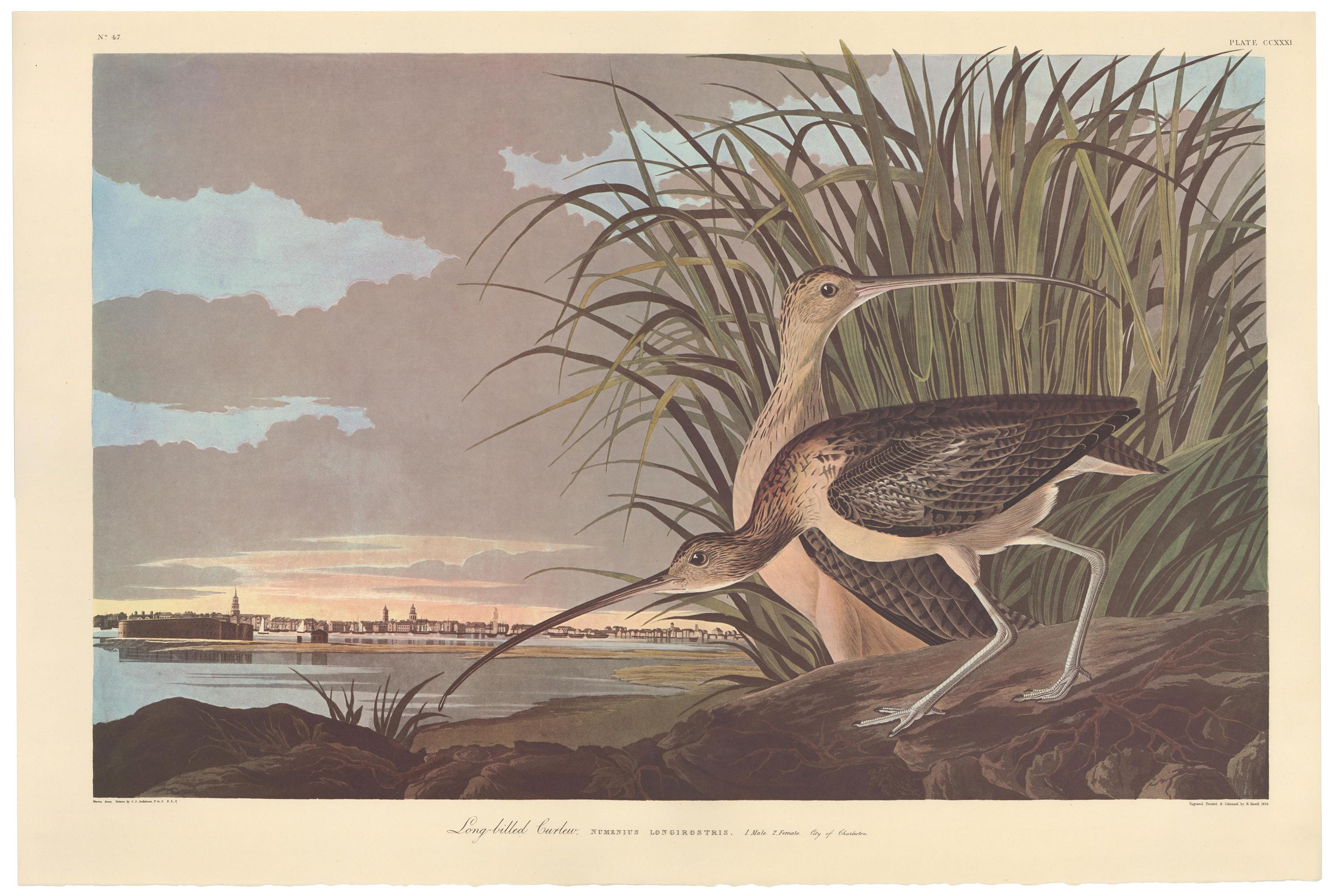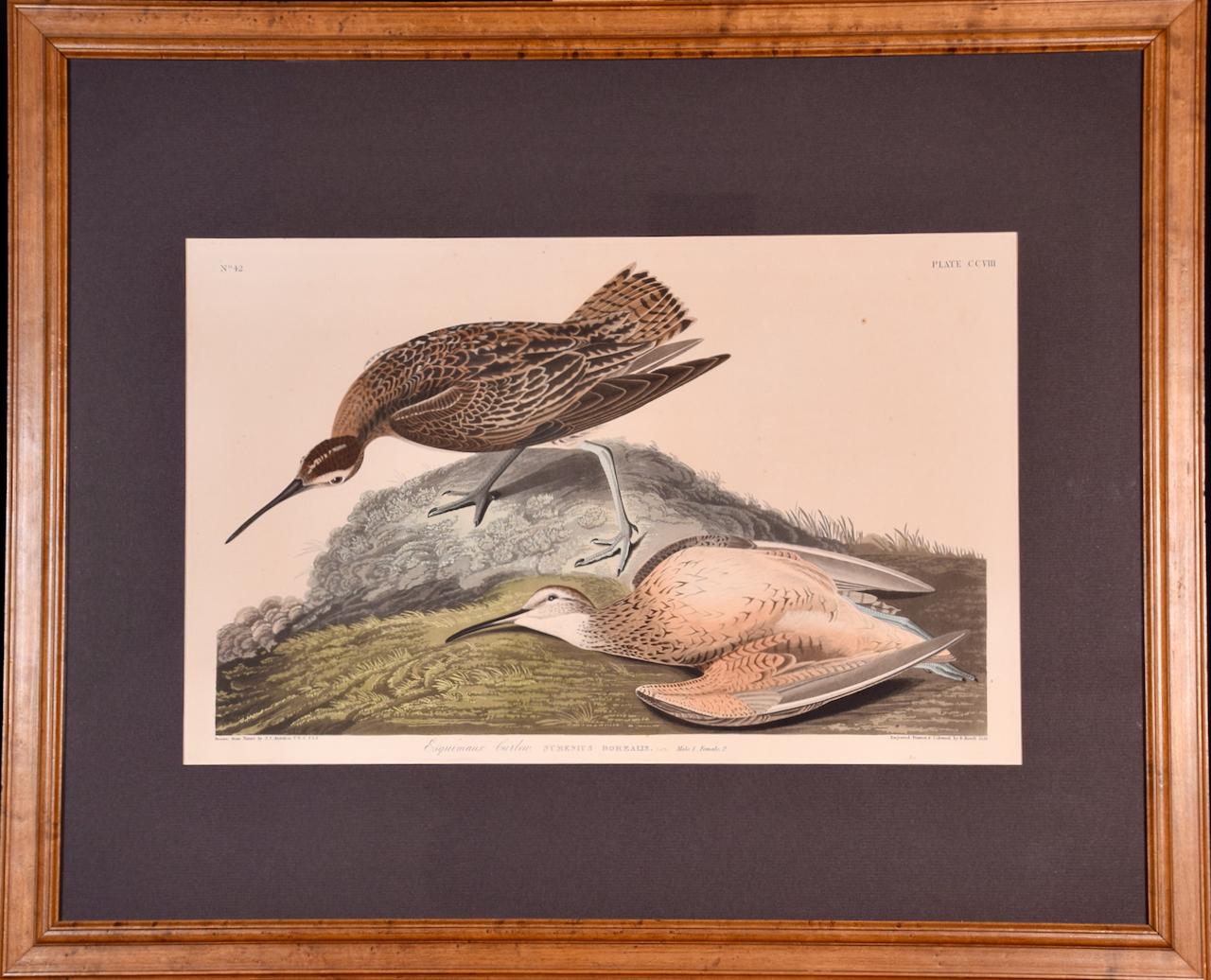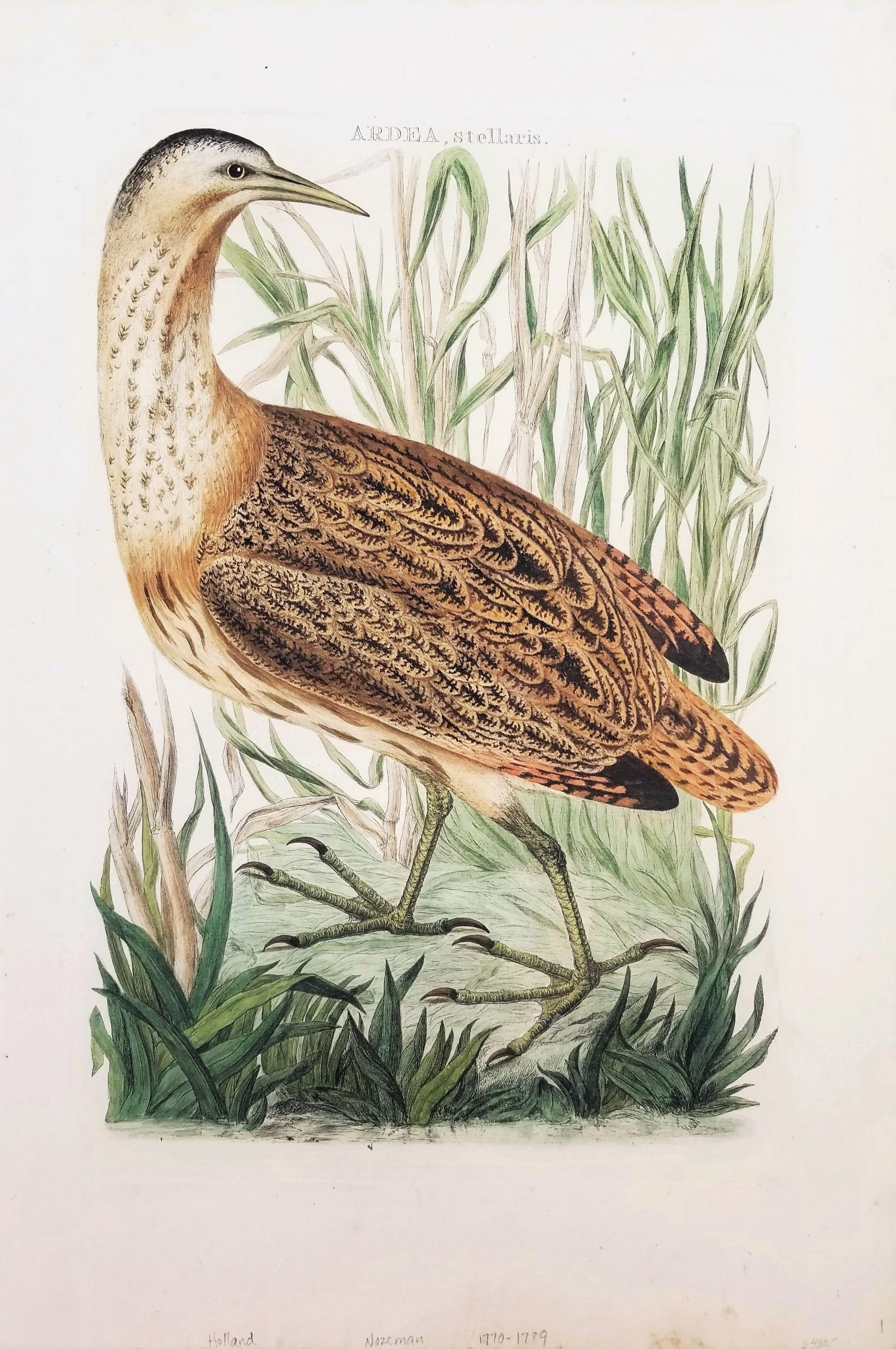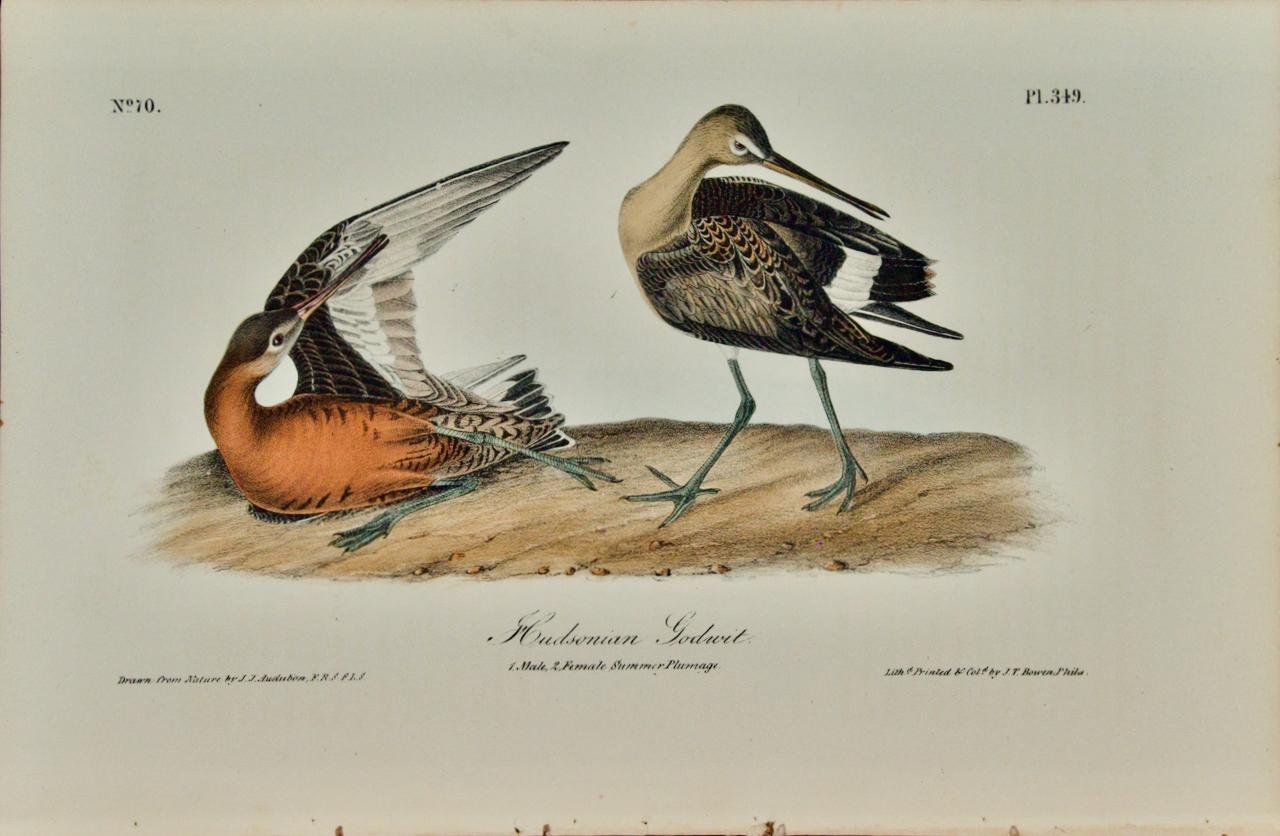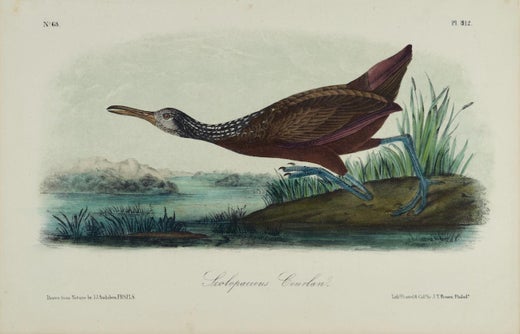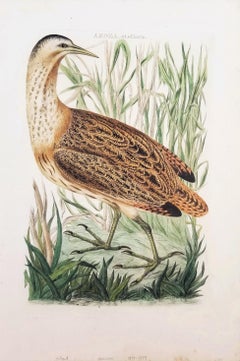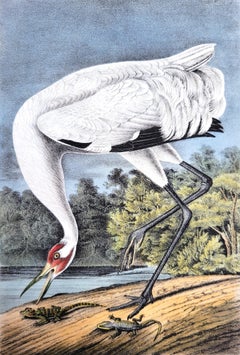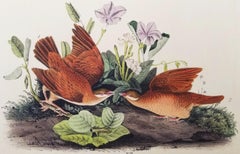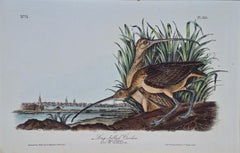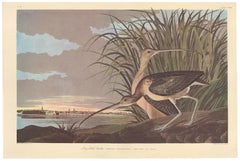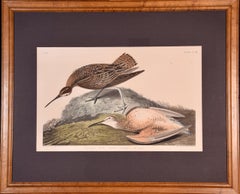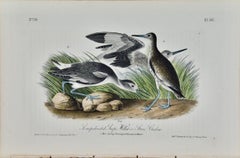Items Similar to Long-billed Curlew (City of Charleston) /// Ornithology John James Audubon Bird
Want more images or videos?
Request additional images or videos from the seller
1 of 17
John James AudubonLong-billed Curlew (City of Charleston) /// Ornithology John James Audubon Bird1840-1844
1840-1844
$1,200
£930.44
€1,055.26
CA$1,720.15
A$1,870.70
CHF 985.53
MX$22,720.01
NOK 12,390.06
SEK 11,614.68
DKK 7,922.58
About the Item
Artist: John James Audubon (American, 1785-1851)
Title: "Long-billed Curlew (City of Charleston)" (Plate 355, No. 71)
Portfolio: The Birds of America, First Royal Octavo Edition
Year: 1840-1844
Medium: Original Hand-Colored Lithograph on wove paper
Limited edition: approx. 1,200
Printer: John T. Bowen, Philadelphia, PA
Publisher: John James Audubon and J.B. Chevalier, New York, NY and Philadelphia, PA
Sheet size: 6.5" x 10.25"
Image size: 4.88" x 9.25"
Condition: Minor toning at edges. A few tiny spots of discoloration. In otherwise excellent condition with strong colors
Notes:
Lithography and hand-coloring by American artist John T. Bowen (1801-c.1856). Comes from Audubon's famous seven volume portfolio "The Birds of America", First Royal Octavo Edition (1840-1844), which consists of 500 hand-colored lithographs.
Based on a composition painted in late October, 1831. Audubon and his assistant, George Lehman, were warmly received in Charleston, SC, and invited by the Reverend John Bachman to stay in his home, from which place Audubon made many important excursions. One such outing to the "Bird Banks" south of Charleston, where great flocks of long-billed curlews were seen, ended with a sumptuous picnic, with Audubon as the chef. They ate "fish, fowl and oysters" procured on the spot, "some steaks of beef, and a sufficiency of good beverage." Salt had been forgotten. Audubon wrote: "I soon proved to my merry companions that hunters can find a good substitute in their powder flasks. Our salt - was gunpowder, as it has been with me many a time; and to our keen appetites, the steaks thus salted were quite savory as many - cooked at home."
The curlews, genus Numenius, are a group of nine species of birds, characterised by long, slender, downcurved bills and mottled brown plumage. The English name is imitative of the Eurasian curlew's call, but may have been influenced by the Old French corliu, "messenger", from courir, "to run".
To make 'The Birds of America' more affordable and widely available, in 1839 John James Audubon began the first octavo edition, a smaller version of the folio which was printed and hand-colored by J. T. Bowen in Philadelphia. Employing a new invention, the camera lucida, the images were reduced in size, rendered in intermediate drawings by John James Audubon and his son John Woodhouse, and then drawn onto lithographic stones. These miniatures exhibit a remarkable amount of attention to quality and detail, as well as a meticulous fidelity to the larger works. Some compositional changes were made in order to accommodate the smaller format. Like the Havell edition, John James Audubon’s first octavo edition was sold by subscription and distributed in parts, five at a time. However, the octavo editions were issued in proper phylogenic, or species order. These prints also bear the plate number in the upper right-hand corner and the subscription number in the upper left. The first edition of approximately 1,200 sets was completed in five years from 1839 to 1844. A total of 500 images comprise the First Royal Octavo Edition.
Biography:
John James Audubon (April 26, 1785, Les Cayes, Saint-Domingue (later Haiti) – January 27, 1851 (aged 65) Manhattan, New York, U.S.), born Jean-Jacques Audubon, was an American ornithologist, naturalist, and painter. He was notable for his expansive studies to document all types of American birds and for his detailed illustrations that depicted the birds in their natural habitats. His major work, a color-plate book entitled The Birds of America (1827–1839), is considered one of the finest ornithological works ever completed. Audubon identified 25 new species.
- Creator:John James Audubon (1785-1851, American, French)
- Creation Year:1840-1844
- Dimensions:Height: 6.5 in (16.51 cm)Width: 10.25 in (26.04 cm)
- Medium:
- Movement & Style:
- Period:
- Condition:
- Gallery Location:Saint Augustine, FL
- Reference Number:1stDibs: LU12128729122
John James Audubon
John James Audubon (April 26, 1785, Les Cayes, Saint-Domingue (later Haiti) – January 27, 1851 (aged 65) Manhattan, New York, U.S.), born Jean-Jacques Audubon, was an American ornithologist, naturalist, and painter. He was notable for his expansive studies to document all types of American birds and for his detailed illustrations that depicted the birds in their natural habitats. His major work, a color-plate book entitled The Birds of America (1827–1839), is considered one of the finest ornithological works ever completed. Audubon identified 25 new species.
About the Seller
5.0
Platinum Seller
Premium sellers with a 4.7+ rating and 24-hour response times
Established in 1978
1stDibs seller since 2015
1,354 sales on 1stDibs
Typical response time: <1 hour
- ShippingRetrieving quote...Shipping from: Saint Augustine, FL
- Return Policy
Authenticity Guarantee
In the unlikely event there’s an issue with an item’s authenticity, contact us within 1 year for a full refund. DetailsMoney-Back Guarantee
If your item is not as described, is damaged in transit, or does not arrive, contact us within 7 days for a full refund. Details24-Hour Cancellation
You have a 24-hour grace period in which to reconsider your purchase, with no questions asked.Vetted Professional Sellers
Our world-class sellers must adhere to strict standards for service and quality, maintaining the integrity of our listings.Price-Match Guarantee
If you find that a seller listed the same item for a lower price elsewhere, we’ll match it.Trusted Global Delivery
Our best-in-class carrier network provides specialized shipping options worldwide, including custom delivery.More From This Seller
View AllArdea, Stellaris (Eurasian Bittern) /// Dutch Ornithology Bird Animal Engraving
By Cornelius Nozeman
Located in Saint Augustine, FL
Artist: Cornelius Nozeman (Dutch, 1720-1786)
Title: "Ardea, Stellaris (Eurasian Bittern)" (Plate 41)
Portfolio: Nederlandsche Vogelen (Dutch Birds)
Year: 1770-1829
Medium: Original H...
Category
1770s Old Masters Animal Prints
Materials
Watercolor, Laid Paper, Engraving, Intaglio
Whooping Crane /// John James Audubon Ornithology Natural History Wading Birds
By John James Audubon
Located in Saint Augustine, FL
Artist: John James Audubon (American, 1785-1851)
Title: "Whooping Crane" (Plate 313, No. 63)
Portfolio: The Birds of America, First Royal Octavo Edition
Year: 1840-1844
Medium: Origi...
Category
1840s Victorian Animal Prints
Materials
Watercolor, Lithograph
Roseate Spoonbill /// John James Audubon Natural History Ornithology Water Bird
By John James Audubon
Located in Saint Augustine, FL
Artist: John James Audubon (American, 1785-1851)
Title: "Roseate Spoonbill" (Plate 362, No. 73)
Portfolio: The Birds of America, First Royal Octavo Edition
Year: 1840-1844
Medium: Original Hand-Colored Lithograph on wove paper
Limited edition: approx. 1,200
Printer: John T. Bowen, Philadelphia, PA
Publisher: John James Audubon and J.B. Chevalier, New York, NY and Philadelphia, PA
Sheet size: 6.75" x 10.44"
Image size: 5" x 7.63"
Condition: In excellent condition
Very rare
The "Roseate Spoonbill" is one of the very top, absolute most desirable birds from Audubon's famous "Birds of America" series
Notes:
Provenance: private collection - Fleming Island, FL. Lithography and hand-coloring by American artist John T. Bowen (1801-c.1856). Comes from Audubon's famous seven volume portfolio "The Birds of America", First Royal Octavo Edition (1840-1844), which consists of 500 hand-colored lithographs.
Based on a composition painted in Florida in 1831 or 1832. "This beautiful and singular bird" was prized for its wings and tail feathers which were made into fans in St. Augustine.
The roseate spoonbill is a gregarious wading bird of the ibis and spoonbill family, Threskiornithidae. It is a resident breeder in both South and North America. The roseate spoonbill's pink color is diet-derived, consisting of the carotenoid pigment canthaxanthin, like the American flamingo.
To make 'The Birds of America' more affordable and widely available, in 1839 John James Audubon began the first octavo edition, a smaller version of the folio which was printed and hand-colored by J. T. Bowen in Philadelphia. Employing a new invention, the camera lucida, the images were reduced in size, rendered in intermediate drawings by John James Audubon and his son John Woodhouse, and then drawn onto lithographic stones. These miniatures exhibit a remarkable amount of attention to quality and detail, as well as a meticulous fidelity to the larger works. Some compositional changes were made in order to accommodate the smaller format. Like the Havell edition, John James Audubon’s first...
Category
1840s Victorian Animal Prints
Materials
Watercolor, Lithograph
Key-West Dove /// Ornithology Bird John James Audubon Shorebird Flowers Plant
By John James Audubon
Located in Saint Augustine, FL
Artist: John James Audubon (American, 1785-1851)
Title: "Key-West Dove" (Plate 282, No. 57)
Portfolio: The Birds of America, First Royal Octavo Edition
Year: 1840-1844
Medium: Origin...
Category
1840s Victorian Animal Prints
Materials
Watercolor, Lithograph
Snowy Heron /// John James Audubon Natural History Ornithology Snowy Egret Bird
By John James Audubon
Located in Saint Augustine, FL
Artist: John James Audubon (American, 1785-1851)
Title: "Snowy Heron" (Plate 374, No. 75)
Portfolio: The Birds of America, First Royal Octavo Edition
Year: 1840-1844
Medium: Original...
Category
1840s Victorian Animal Prints
Materials
Watercolor, Lithograph
Florida Cormorant /// John James Audubon Ornithology Bird Art Natural History
By John James Audubon
Located in Saint Augustine, FL
Artist: John James Audubon (American, 1785-1851)
Title: "Florida Cormorant" (Plate 417, No. 84)
Portfolio: The Birds of America, First Royal Octavo Edition
Year: 1840-1844
Medium: Original Hand-Colored Lithograph on wove paper
Limited edition: approx. 1,200
Printer: John T. Bowen, Philadelphia, PA
Publisher: John James Audubon and J.B. Chevalier, New York, NY and Philadelphia, PA
Sheet size: 6.5" x 10.44"
Image size: 3.75" x 6.25"
Condition: Some minor discoloration upper center in margin. In excellent condition with strong colors
Notes:
Provenance: private collection - Cleveland, OH. Lithography and hand-coloring by American artist John T. Bowen (1801-c.1856). Comes from Audubon's famous seven volume portfolio "The Birds of America", First Royal Octavo Edition (1840-1844), which consists of 500 hand-colored lithographs.
Based on a composition painted in the Florida Keys on April 26, 1832, Audubon's forty-seventh birthday.
The double-crested cormorant (Nannopterum auritum) is a member of the cormorant family of water birds. It is found near rivers and lakes and in coastal areas and is widely distributed across North America, from the Aleutian Islands in Alaska down to Florida and Mexico. Measuring 70–90 cm (28–35 in) in length, it is entirely black except for a bare patch of orange-yellow facial skin and some extra plumage that it exhibits in the breeding season when it grows a double crest in which black feathers are mingled with white. Five subspecies are recognized. It mainly eats fish and hunts by swimming and diving. Its feathers, like all cormorants, are not waterproof, and it must dry them out after spending time in the water. Once threatened by the use of DDT, the numbers of this bird have increased markedly in recent years.
To make 'The Birds of America' more affordable and widely available, in 1839 John James Audubon began the first octavo edition, a smaller version of the folio which was printed and hand-colored by J. T. Bowen in Philadelphia. Employing a new invention, the camera lucida, the images were reduced in size, rendered in intermediate drawings by John James Audubon and his son John Woodhouse, and then drawn onto lithographic stones. These miniatures exhibit a remarkable amount of attention to quality and detail, as well as a meticulous fidelity to the larger works. Some compositional changes were made in order to accommodate the smaller format. Like the Havell edition, John James Audubon’s first...
Category
1840s Victorian Animal Prints
Materials
Watercolor, Lithograph
You May Also Like
Long-billed Curlew Bird: Original 1st Edition Audubon Hand Colored Lithograph
By John James Audubon
Located in Alamo, CA
An original rare and extremely collectible first edition John James Audubon hand colored lithograph entitled "Long-billed Curlew", No. 71, Plate 355, from Audubon's "Birds of America. It was lithographed, printed and colored by J. T. Bowen and published in Philadelphia between 1840-1844. It depicts a male and a female Long-billed Curlew standing on a grassy mound with water and the city of Charleston...
Category
Mid-18th Century Naturalistic Animal Prints
Materials
Lithograph
Long-Billed Curlew after John James Audubon, Amsterdam Edition
By John James Audubon
Located in New York, NY
Plate CCXXXI, Long-billed Curlew, posthumous reproduction after John James Audubon from The Birds of America, the Amsterdam Edition, printed in Amsterdam, 1971-73. Original multicolored photo-offset print. "G Schut and Zonen" watermark at lower edge of paper. A facsimile from the double-elephant folio...
Category
1970s Prints and Multiples
Materials
Paper
"Esquimaux Curlew": A Framed Original Audubon Hand-colored Folio Engraving
By John James Audubon
Located in Alamo, CA
This is an original hand-colored folio edition John James Audubon engraving entitled "Esquimaux Curlew", Folio, Pl. CCVIII", No. 42, Plate 208, from Audubon's "Birds of America". It was engraved, printed and colored in London by Robert Havell, Jr. in 1834. It depicts a male and a female Esquimaux Curlew birds...
Category
Mid-19th Century Naturalistic Animal Prints
Materials
Engraving
Willet or Stone Curlew: A First Octavo Edition Audubon Hand-colored Lithograph
By John James Audubon
Located in Alamo, CA
This is an original John James Audubon hand-colored royal first octavo edition lithograph entitled "Semipalmated Snipe, Willet or Stone Curlew, 1. ...
Category
Mid-19th Century Naturalistic Animal Prints
Materials
Lithograph
Hudsonian Godwit 19th C. 1st Octavo Edition Audubon Hand-colored Bird Lithograph
By John James Audubon
Located in Alamo, CA
This is an original 19th century John James Audubon hand-colored 1st octavo edition lithograph entitled "Hudsonian Godwit, 1. Male, 2. Female, Summer Plumage", No. 70, Plate 349 from...
Category
Mid-19th Century Naturalistic Animal Prints
Materials
Lithograph
Curlew - Woodcut Print by Alexander Francis Lydon - 1870
Located in Roma, IT
Curlew is a modern artwork realized in 1870 by the British artist Alexander Francis Lydon (1836-1917).
Woodcut print on ivory-colored paper.
Hand-colored, published by London, Bell...
Category
1870s Modern Figurative Prints
Materials
Woodcut
More Ways To Browse
Long John
Charleston Antique
Antique Powder Flasks
Curlew Bird
Picasso Lithograph Owl
Picasso Print Dove
Poster Aesthetic Vintage Art
Prairie Dog
Signed Duck Art Prints
Simon Bussy
Strato Lounger
Tete De Taureau
Tortoise And Hare Vintage
Ulisse Aldrovandi
Vintage Fetish Shoes
Albion Printing Press
Andy Warhol Pussy
Audubon Hawk
